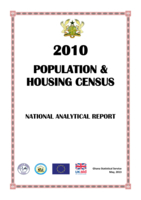2010 Population & Housing Census: National Analytical Report (Ghana)

Ghana’s most recent census, in 2010, was its 5th since independence in 1957. This report summarizes the trove of data from the census, broadly covering aspects of population structure, households, marital characteristics, education, fertility, mortality, migration, urbanization, economic activities, agriculture, disabilities, technology, and housing. It also gives detailed information about methodology and logistics in gathering these data.
The urban and rural data are not further disaggregated, for instance into different income groupings, or into formal and informal areas. The report recognizes Ghana’s inadequate system for classifying urban settlements, which currently depends only on the number of residents rather than taking into account aspects like density. Informal settlements are mentioned only in passing – for example, in noting that Greater Accra has the highest proportion of makeshift dwellings (6.1% of homes there), due to the presence of informal settlements. Nor does the report detail changes in urban areas over time, as a rule. The Ghana Statistical Service has not made accessible the more granular data on enumeration areas, districts, and trends over time.
Even with this lack of urban disaggregation, it is possible to discern patterns that distinguish Greater Accra and Ashanti, the country’s most urbanized regions, from the other regions. For example, Greater Accra, which is 90.5% urban, features high use of:
· Sachet drinking water (28% vs. 13.9% across Ghana’s urban areas)
· Tanker-vendor provided water for domestic use (6.2% vs. 2.7% across Ghana’s urban areas)
· Household collection of solid waste (48.5% vs. 22.1% across Ghana’s urban areas)
One general milestone is that 2010 was the first census year when Ghana had an urban population over 50%. This numbered 12.5 million in 2010, a 4.2% increase from 2000. The report posits that urban growth is attributable to high (but declining) fertility and declining mortality, while the main drivers of Ghana’s urbanisation include rural–urban migration, natural increases in towns and cities, and reclassification of villages once their population reaches 5,000.
Some of the data show steady, if slow, progress in raising urban living standards. The use of mains electricity as the main source of urban lighting increased to 83.8% of urban households in 2010 from 74.6% in 2000, while the primary use of kerosene lamps fell from 28.1% to 8.4%. However, electricity has become less common as the main energy source for cooking, due to the expense and unreliability of electricity. These factors have also limited the take-up of gas for cooking in urban areas. While this grew substantially from 11.8% in 2000 to 28.9% in 2010, charcoal remains predominant (47.9%).
As an analytical report, this document uses the data findings to make recommendations about policy, such as greater attention to sewerage systems, and to discuss the consequences of government regulations, such as the banning of bucket/pan latrines in Ghana, which led to the building of public toilets. The report also recommends integrated policy to manage urbanization, particularly to Greater Accra. For instance, it notes, “the population density of Greater Accra increased from 896 in 2000 to 1,236 person per square kilometer. This high concentration of people, with its associated infrastructural needs, presents its own challenges for the planning and development of the national capital” (403).
Thus the report is useful for researchers as well as policymakers. Among other things, it may help to visualize the uses and abuses of data – in terms of what information exists as well as what may be missing.
Available from:
http://www.statsghana.gov.gh/docfiles/2010phc/National_Analytical_Report.pdf
Further reading:
Baptist, Carrie and Joel Bolnick (2012), “Participatory enumerations, in situ upgrading and mega events: the 2009 survey in Joe Slovo, Cape Town”, Environment and Urbanization Vol 24, No 1, pages 59–66, available at http://eau.sagepub.com/content/24/1/59.abstract.
Dodman, David, Daniel Schensul and Sainan Zhang (2013), “Demographic data as a tool for adaptation planning”, Technical briefing, United Nations Population Fund and International Institute for Environment and Development, New York and London, 4 pages, available at http://pubs.iied.org/G03705.html?k=census.
United Nations Statistics Division (n.d.), 2010 World Population and Housing Census Programme, UN Department of Economic and Social Affairs, available at http://unstats.un.org/unsd/demographic/sources/census/2010_PHC/default.htm.
Book note prepared by Christine Ro
Search the Book notes database
Our Book notes database contains details and summaries of all the publications included in Book notes since 1993 - with details on how to obtain/download.
Use the search form above, or visit the Book notes landing page for more options and latest content.
For a searchable database for papers in Environment and Urbanization, go to http://eau.sagepub.com/

